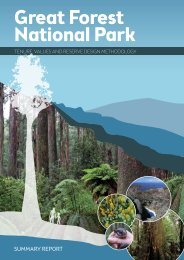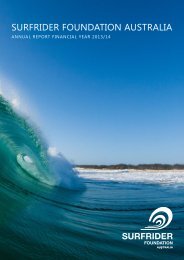EXPLORING VICTORIA’S NATIONAL PARKS
Victoria's national parks are open to everyone, 24 hours a day, 365 days a year, so it's not surprising they attract 35 million visitors annually. Many parks have facilities and special tracks for people who are less mobile or need a wheelchair, and in some parks there are even all-terrain wheelchairs available. And while our parks are open for all Victorians to enjoy they also exist as the only way to give long-term protection to our native plants and animals by protecting the places in which they live.
Victoria's national parks are open to everyone, 24 hours a day, 365 days a year, so it's not surprising they attract 35 million visitors annually.
Many parks have facilities and special tracks for people who are less mobile or need a wheelchair, and in some parks there are even all-terrain wheelchairs available.
And while our parks are open for all Victorians to enjoy they also exist as the only way to give long-term protection to our native plants and animals by protecting the places in which they live.
Create successful ePaper yourself
Turn your PDF publications into a flip-book with our unique Google optimized e-Paper software.
Q. WHY ARE THERE SO MANY<br />
DIFFERENT TYPES OF PARK?<br />
The park system is complex<br />
because nature is complex,<br />
and so are the many<br />
impacts people have on natural<br />
areas.<br />
The idea is to create a conservation<br />
network made up of different<br />
land tenures and management<br />
systems, matching the conservation<br />
importance of each area, its<br />
condition, and current and potential<br />
appropriate uses.<br />
The public land tenure system in<br />
Victoria is governed by a number<br />
of pieces of legislation, but also<br />
reflects a range of national and<br />
international treaties and policies.<br />
Generally speaking, a protected area<br />
is a park or reserve with a primary<br />
aim of biodiversity conservation –<br />
creating areas in which our native<br />
plants and animals can survive and<br />
flourish. International thinking has<br />
been led by the International Union<br />
for Conservation of Nature (IUCN),<br />
which has developed globally<br />
recognised standard definitions and<br />
classifications for protected areas.<br />
The internationally recognised<br />
categories are:<br />
Ia Strict Nature Reserve: managed<br />
mainly for science<br />
These are strictly protected areas<br />
set aside to protect biodiversity and<br />
geological features, where human<br />
visitation, use and impacts are<br />
strictly controlled and limited.<br />
Ib Wilderness Area<br />
These protected areas are usually<br />
large, unmodified or slightly<br />
modified areas of land or sea,<br />
retaining their natural character<br />
and influence without permanent<br />
or significant human habitation.<br />
They are managed to protect their<br />
natural condition.<br />
II National Park<br />
These protected areas are large<br />
natural or near natural areas<br />
set aside to protect large-scale<br />
ecological processes, along with<br />
the complement of species and<br />
ecosystems characteristic of<br />
the area, which also provide a<br />
foundation for environmentally<br />
and culturally compatible, spiritual,<br />
scientific, educational, recreational,<br />
and visitor opportunities.<br />
III Natural Monument or Feature<br />
Category III areas protect a natural<br />
or cultural feature, such as a<br />
landform, submarine cavern, or<br />
even a living feature such as an<br />
ancient grove. They are generally<br />
quite small protected areas and<br />
often have high visitor value.<br />
IV Habitat/Species Management<br />
Area<br />
Category IV protected areas aim<br />
to protect particular species or<br />
habitats and management reflects<br />
this priority. Many Category IV<br />
protected areas will need regular,<br />
active interventions to address the<br />
requirements of particular species<br />
or to maintain habitats.<br />
V Protected Landscape/Seascape<br />
These are protected areas where<br />
the interaction of people and nature<br />
over time has produced an area of<br />
distinct character with significant<br />
ecological, biological, cultural and/<br />
or scenic value.<br />
VI Protected area with sustainable<br />
use of natural resources<br />
Category VI protected areas<br />
conserve ecosystems and habitats<br />
together with associated cultural<br />
values and traditional natural<br />
resource management systems.<br />
They are generally large, with<br />
most of the area in a natural<br />
condition, but where low-level<br />
non-industrial use of natural<br />
resources is compatible with nature<br />
conservation it is seen as one of the<br />
main aims of the area.<br />
In Victoria, protected areas include<br />
reference areas, national, state,<br />
wilderness and some regional<br />
parks, nature conservation reserves,<br />
heritage rivers and some natural<br />
features reserves.<br />
Some other categories of land<br />
known as ‘parks’ or ‘reserves’ are<br />
not considered true protected areas<br />
because their primary purpose<br />
is not biodiversity conservation<br />
(e.g. some regional parks, historic<br />
reserves, lake reserves, highway<br />
parks and metropolitan parks).<br />
The dedicated status of land in the<br />
categories included in the reserve<br />
system is conferred by one of<br />
four Parliamentary Acts. Broadly<br />
speaking, national, state and some<br />
other parks are scheduled and<br />
managed under the National Parks<br />
Act 1975, nature conservation<br />
reserves and natural features<br />
reserves are reserved and managed<br />
under the Crown Land (Reserves)<br />
Act 1978, reference areas are<br />
proclaimed and managed under<br />
the Reference Areas Act 1978, and<br />
heritage rivers are proclaimed and<br />
managed under the Heritage Rivers<br />
Act 1992.<br />
YOUR QUESTIONS ANSWERED 15







